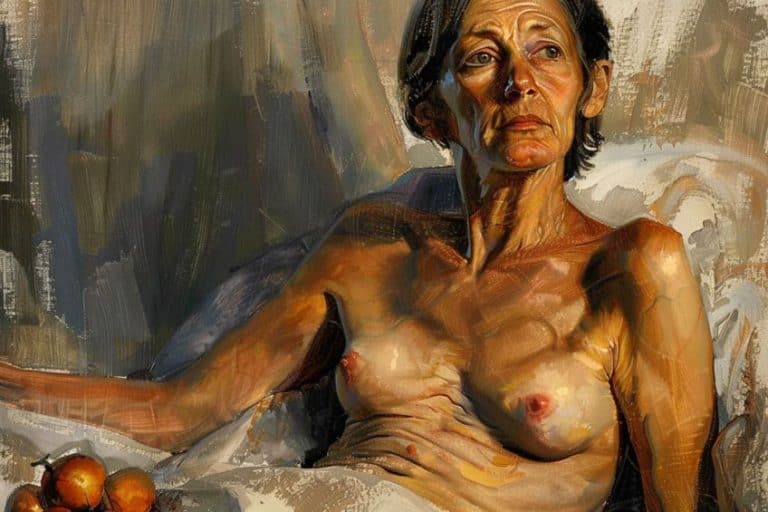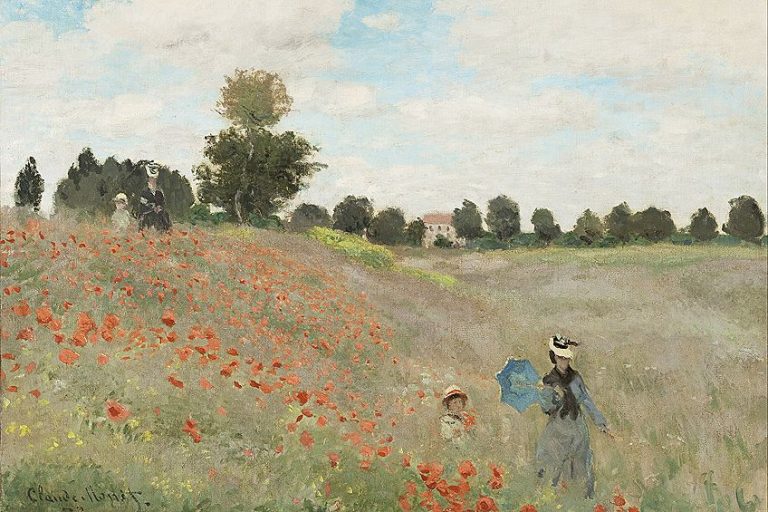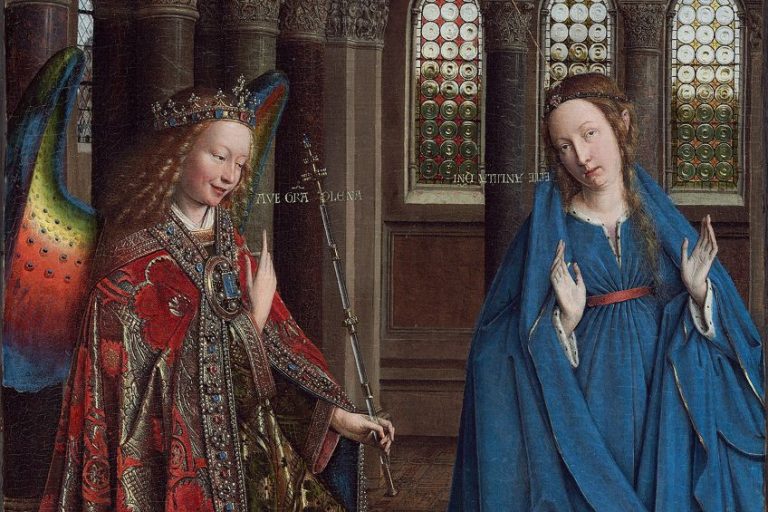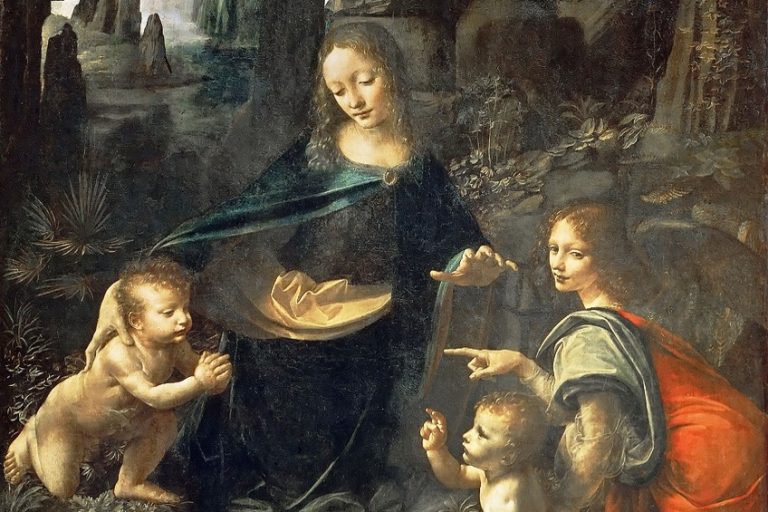Famous Baroque Paintings – Exploring the Best Baroque Period Artworks
Before the Rococo and Neoclassical styles, there was Baroque period artwork, which came after Renaissance and Mannerist art. It initially started to flourish in Europe between the beginning of the 17th century and the middle of the 18th century. Artists of the era created magnificent Baroque artworks that may be identified by their use of rich colors, thrilling details, contrast, and a feeling of splendor.
Table of Contents
- 1 Famous Baroque Paintings
- 1.1 The Battle of the Amazons (c. 1615) by Peter Paul Rubens and Jan Bruegel the Elder
- 1.2 The Calling of St Matthew (1600) by Caravaggio
- 1.3 Judith Slaying Holofernes (c.1612) by Artemisia Gentileschi
- 1.4 Education of the Princess (1625) by Peter Paul Rubens
- 1.5 The Abduction of the Sabine Women (1634) by Nicolas Poussin
- 1.6 The Judgment of Paris (c. 1632) by Peter Paul Rubens
- 1.7 The Night Watch (1642) by Rembrandt van Rijn
- 1.8 Allegory of War (c. 1640) by Jan Brueghel the Younger
- 1.9 Portrait of Innocent X (1650) by Diego Velázquez
- 1.10 Landscape with a Calm (1651) by Nicolas Poussin
- 1.11 Las Meninas (1656) by Diego Velázquez
- 1.12 The Milkmaid (1658) by Johannes Vermeer
- 1.13 Portia Wounding Her Thigh (1664) by Elisabetta Sirani
- 1.14 The Return of the Prodigal Son (1669) by Rembrandt van Rijn
- 1.15 The Love Letter (c. 1669) by Johannes Vermeer
- 2 Frequently Asked Questions
Famous Baroque Paintings
The stunning realism and vibrant subject matter of Baroque painting set it apart from previous times. By focusing on spiritual and theological themes throughout the Baroque period, painters attempted to convey the visual drama or action of their day. To its adherents, baroque art has always been associated with the Catholic Church, and it was intended to evoke devotion and amazement.
The style’s decoration is lavish and elaborate in the ornamental arts. Each country’s divergence from Renaissance classicism takes on a different form.
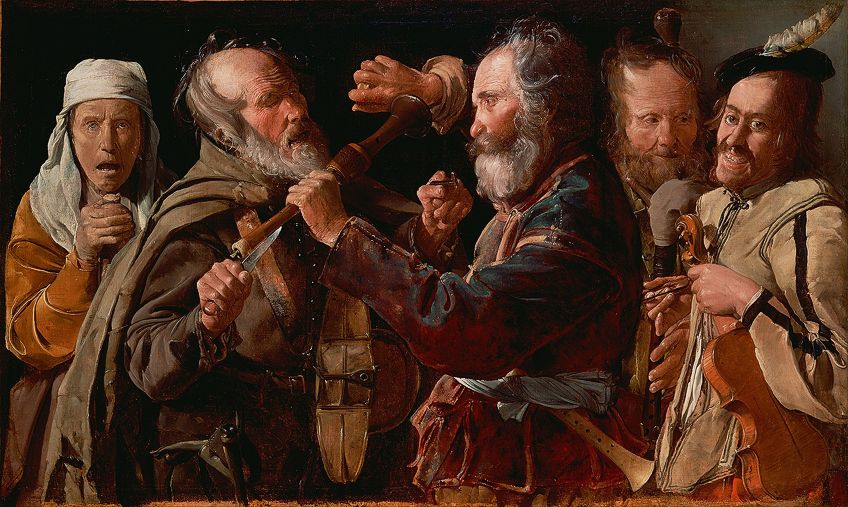
However, a repetitive element is that the decorative features used throughout the Renaissance serve as a jumping-off point. There is a lot of material in the classical tradition that is rich, overlapping, and laden in order to elicit emotional responses. The papyrus scroll, medals and weaponry, fruit or flower baskets, and other elements constructed of moldings, stucco, or carvings were introduced by the Baroque period.
Today, we’ll learn about some of the most famous Baroque paintings that have had a lasting impression on the history of art.
The Battle of the Amazons (c. 1615) by Peter Paul Rubens and Jan Bruegel the Elder
| Date of Painting’s Creation | c. 1615 |
| Medium of Artwork | Oil on Canvas |
| Artwork’s Dimensions | 121 cm × 165.5 cm |
| Place Currently Housed | Gärten Berlin-Brandenburg, Potsdam |
At the beginning of the seventeenth century, the two most famous painters of Antwerp were Jan Bruegel the Elder and Peter Paul Rubens. Jan “Velvet” Brueghel, a prominent landscape and still-life painter was the elder of the two by nine years and was famous for his incredibly precise and jewel-like works. Rubens was an ambitious painter who reconstructed ancient and Renaissance materials in his altarpieces and learned mythological and historical topics.
Both artists also worked for Archduke Albert and Archduchess Isabella. They were also close friends on a personal level.
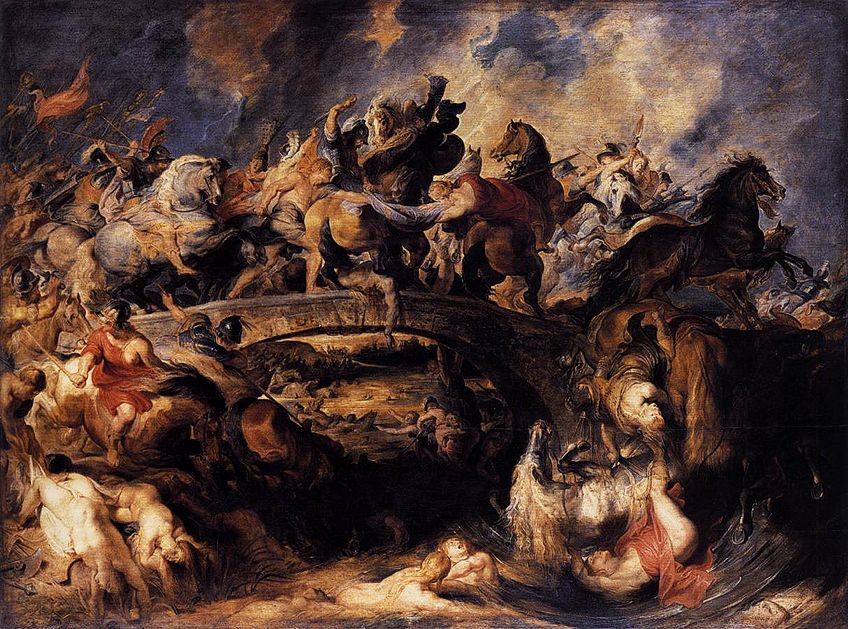
They collaborated to create one of the most iconic masterworks of the Baroque period artwork, The Battle of the Amazons. While numerous artists have replicated this work, it was these two who first brought it to light, painting the iconic piece between 1617 and 1618. The picture is reminiscent of Leonardo da Vinci’s masterwork, which is likewise based on the Battle of the Amazons. Rubens was well-known for imitating some of the finest Italian masterpieces of all time while adding his own unique spin to each one.
This is one of his first and most prominent paintings, and it is seen as more of a homage to Leonardo himself and his famed style of painting, which Ruben and Jan Bruegel attempted to replicate in their own works.
The Calling of St Matthew (1600) by Caravaggio
| Date of Painting’s Creation | 1600 |
| Medium of Artwork | Oil on Canvas |
| Artwork’s Dimensions | 322 cm x 340 cm |
| Place Currently Housed | Contarelli Chapel |
This early 17th-century artwork portrays the instant when Jesus Christ encourages Matthew to become an apostle and a follower of his. The artwork was requested by Cardinal Matthew Contarelli, who gave funds and directions for the decorating of a chapel based on events from the legacy of Saint Matthew, his namesake The popular Mannerist painter Cavaliere d’Arpino had already painted the chapel’s ceiling with frescoes, but he was too busy with papal work to do the walls, so Del Monte stepped in to win the commission for Caravaggio.
For this picture, Caravaggio uses elements from his previous genre work and places the action in what looks to be a bar rather than an accounting office or a courtroom.

Caravaggio uses a succession of casual images to communicate the hallowed aspect of the situation, as he did in many of his Christian works. Here, for example, the stylish tax collector and his well-dressed colleagues – all busy calculating the day’s profits – are contrasted with the barefoot Christ. As a result, Jesus not only looks upon a sinner like Levi but also shines the illuminating light of faith into Levi’s gloomy world of monetary gluttony.
For example, notice how Levi retains his right hand on the currency he was counting before Christ interrupted him.
Judith Slaying Holofernes (c.1612) by Artemisia Gentileschi
| Date of Painting’s Creation | c. 1612-1613 |
| Medium of Artwork | Oil on Canvas |
| Artwork’s Dimensions | 158 cm x 125 cm |
| Place Currently Housed | Museo e Real Bosco di Capodimonte |
Artemisia Gentileschi was a Baroque painter from Italy who is now cited as one of the most talented painters of her period as well as one of the finest female artists of all time. One of her most well-known Baroque artworks is Judith Slaying Holofernes. After dressing in her best garments, Judith set out for Holofernes’ camp, pretending to be interested in forming a partnership with the ruthless general. The Assyrian general was so taken by her beauty that he threw her a magnificent party in his tent.
Holofernes, who had overindulged on food and wine, passed out on his bed, leaving Judith the opportunity to draw her cutlass and deliver the fatal strike.

The whole effect is striking and terrifying: the booze-swollen general is lying on the bed, his hair wrapped around his head and the sword buried deep into his neck. Artemisia also did not hold back in including the horrific detail of Judith’s bosom being stained by the gushing blood. As a result, this picture has come to symbolize the story of a woman who chose to be an artist during a time when the field was controlled by men.
In Rome, where Artemisia had returned after seven years in Florence and had the opportunity to rediscover Caravaggio’s art, the picture was finished.
Education of the Princess (1625) by Peter Paul Rubens
| Date of Painting’s Creation | 1625 |
| Medium of Artwork | Oil on Canvas |
| Artwork’s Dimensions | 394 cm by 295 cm |
| Place Currently Housed | Louver Museum |
The Marie de’ Medici Cycle is a set of 24 paintings contracted by Marie de’ Medici, Henry IV of France’s widow, for the Luxembourg Palace in Paris. The contract was given to Rubens in the late fall of 1621. The project was set to be completed in two years, just in time for Marie’s daughter Henrietta Maria to get married. As many as 21 of the paintings represent Marie’s personal challenges and achievements throughout her life, and the final three works are all portraits of her, including one of her parents.
The paintings are presently housed at the Louvre Museum in Paris.
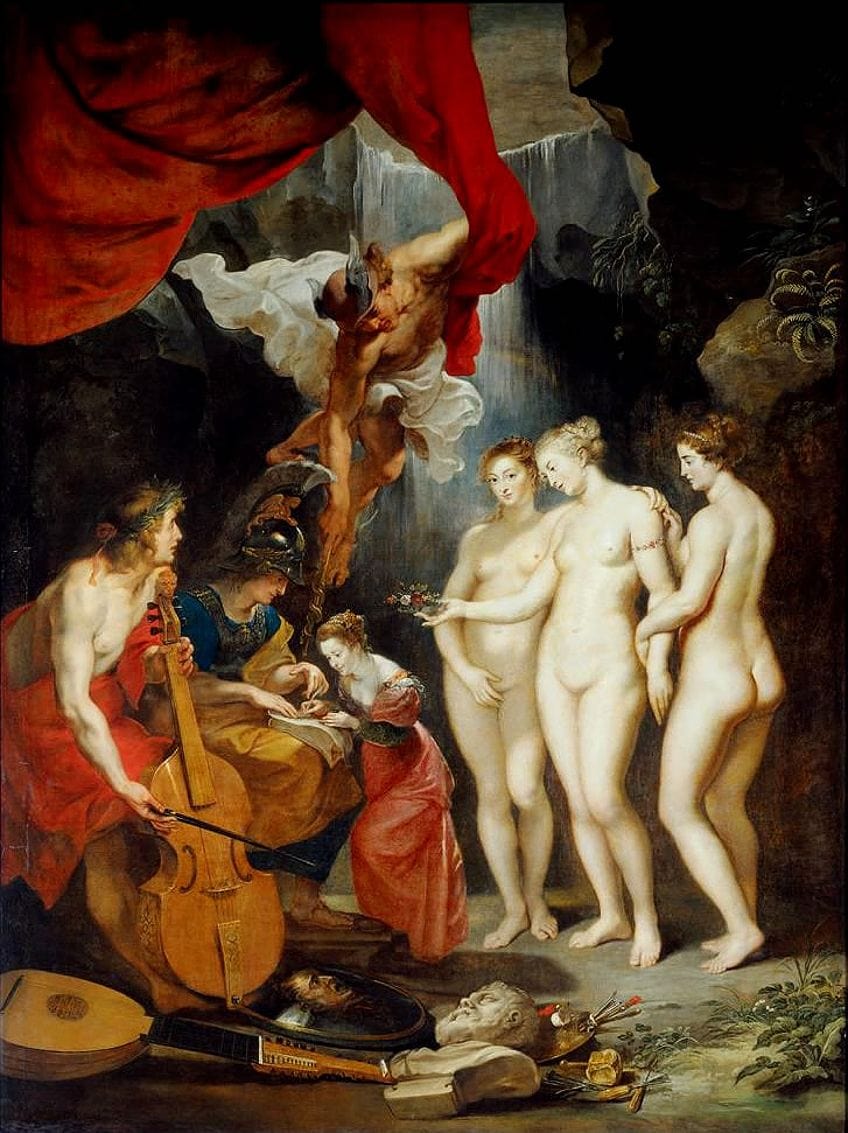
This 17th-century artwork depicts a young Marie de’ Medici doing her homework. The presence of three gods, Hermes, Athena, and Apollo, enhances her education with divinity. Apollo is the god of art, Athena the goddess of knowledge, and Hermes the messenger god are all linked to linguistic fluency and comprehension. Dramatically, Hermes appears on the scene and presents the caduceus, which he claims was given to him by the gods.
According to popular belief, Hermes bestows the princess with the gift of eloquence in addition to Grace’s beauty. The caduceus is a symbol of healing and balance, and it appears in six other paintings in the cycle.
The Abduction of the Sabine Women (1634) by Nicolas Poussin
| Date of Painting’s Creation | 1643 |
| Medium of Artwork | Oil on Canvas |
| Artwork’s Dimensions | 154 cm x 209 cm |
| Place Currently Housed | Met Gallery |
Not every renowned Italian Baroque painting depicted a religious or contemporary event. The Abduction of the Sabine Women, a painting by Nicolas Poussin, was based on a well-known Roman mythical narrative of the time. Poussin, a significant character in Baroque painting, was a philosopher-painter whose work offers some of the best instances of formal harmonization and balance.
There is a lot of drama in this picture, which dates back to 1634, and it’s full of bright hues.
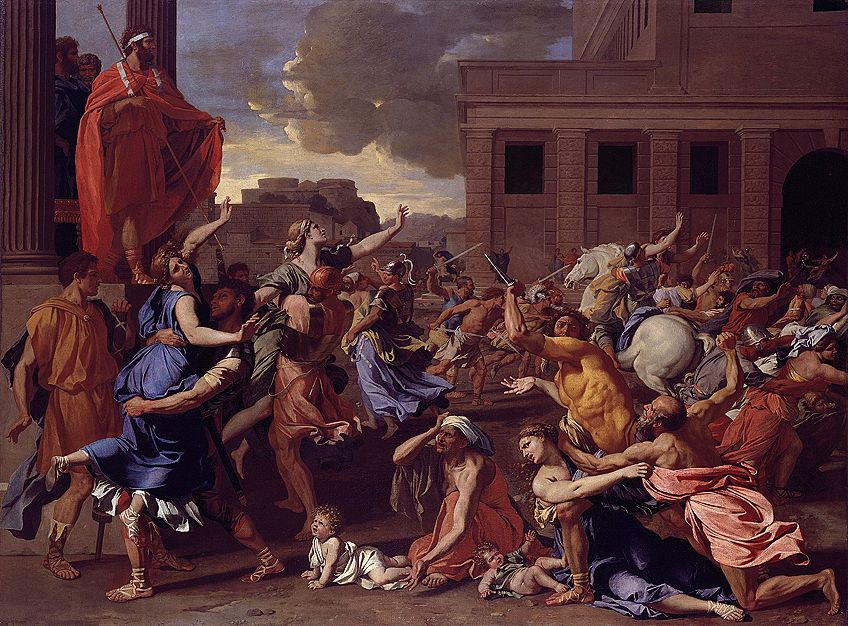
In Roman legend, the Sabines, who lived nearby, were summoned to a celebration in order to keep their young ladies as spouses against their will. Soldiers swooped in to grab the women when Roman general Romulus lifted his cloak. Poussin’s mastery of gesture and stance, as well as his understanding of ancient art and architecture, were on show in this dramatic narrative. The man on the right is dressed in all black, but for his leather lorica, which is yellow.
Originally, the picture belonged to Maréchal de Créquy, France’s ambassador to Rome from June 1633 to July 1634. He later sold it to Cardinal Richelieu for a little fortune.
The Judgment of Paris (c. 1632) by Peter Paul Rubens
| Date of Painting’s Creation | c. 1632-1635 |
| Medium of Artwork | Oil on Canvas |
| Artwork’s Dimensions | 199 cm x 381 cm |
| Place Currently Housed | Prado Museum |
Only Eris, the goddess of discord, was left out of an important wedding. She flung an apple made from gold engraved with the words ‘To the Fairest’ to the other attending goddesses at the feast, out of rage. Venus, Juno, and Minerva were the three who put their names forth for consideration. The gods’ leader, Jupiter, decreed that Paris be the judge. Even though he had been brought up as a shepherd, the young man turned up to be a prince of Troy.
Rubens captured this pivotal moment in time within his painting: Paris presents Venus, the goddess of beauty, with the golden apple.
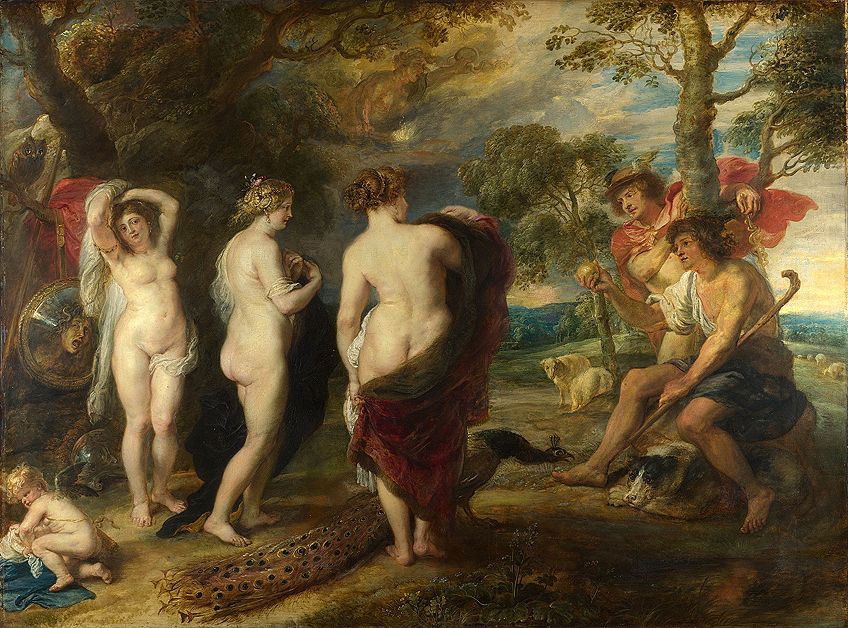
All of the goddesses had lied to the gods. Paris was offered money and power by Juno, and intelligence and might by Minerva. Venus had promised him Helen of Sparta, the most beautiful lady in the world, as well as an enticing present. It’s impossible to miss Alecto, the unyielding Fury, lurking in the clouds high above them. Juno, enraged and enraged, ordered her to slay the Trojans in a passion. As a result of her actions, Paris kidnapped Helen, sparking the infamous Trojan War.
The Night Watch (1642) by Rembrandt van Rijn
| Date of Painting’s Creation | 1642 |
| Medium of Artwork | Oil on Canvas |
| Artwork’s Dimensions | 363 cm x 437 cm |
| Place Currently Housed | Rijksmuseum |
Rembrandt van Rijn, a well-known Dutch artist, painted The Night Watch in 1642. It is the most well-known work of art in the Rijksmuseum’s collection and is now on display there. This oil painting on canvas, created during the Dutch Golden Age, is considered noteworthy. The huge canvas and Rembrandt’s skillful use of lighting and shadows to produce an effect that was very dramatic, known as tenebrism, made it a popular choice for admirers.
He was able to concentrate the viewer’s attention on the two men strolling in the front and the old woman in the distance by using dark and bright sections in the picture.

The two men shown are members of the company’s volunteer military guard, as they’re departing for the night. Behind the other two men, an ensign is flying the company’s flag. Because it’s so big, the characters in the picture are nearly life-size. Rembrandt has shown the infantrymen’s traditional insignia in a natural style, with the lady in the background bearing the most important emblems. She’s a mascot in and of herself; the claws of a dead chicken on her belt symbolize the infantrymen, the gun behind the bird signifies clover, and she’s carrying the army’s chalice. He’s sporting an oak-leaf helmet, which is a typical army insignia.
The carcass of the chicken can also signify a vanquished foe, and the color yellow is frequently connected to success.
Allegory of War (c. 1640) by Jan Brueghel the Younger
| Date of Painting’s Creation | c. 1640 |
| Medium of Artwork | Oil on Canvas |
| Artwork’s Dimensions | 79 cm x 97 cm |
| Place Currently Housed | Private Collection |
This Baroque period artwork was created in the late 1640s, just as Europe was coming to terms with the Thirty Years’ War. This was a large-scale conflict that had devastating effects across Europe, resulting in the deaths of nearly eight million people. A major impact on Breughel’s landscapes is his depiction of the Thirty Years’ War. This picture is loaded with meaning, as implied by the title. This picture has a mix of confusing and clear figures.
Weapons such as firearms, skulls, and daggers portray death and combat, while animal teeth show a more primitive side.

The artwork portrays a city in disarray. It’s possible to witness weaponry strewn across the ground, along with lions, canines, and birds engaged in combat to protect them. This stresses the world’s entire cruelty and warfare, most likely as a result of the European Civil War coming to a close. Numerous persons may be found in the picture, but the two most prominent are a soldier in full plate armor and a crimson cloak, and a person in toga-style clothing holding a torch who appears to be a dissident. Two enormous skulls lie on the ground, drawing attention to the reality of death.
A burning city with collapsing walls may be seen in the backdrop.
Portrait of Innocent X (1650) by Diego Velázquez
| Date of Painting’s Creation | 1650 |
| Medium of Artwork | Oil on Canvas |
| Artwork’s Dimensions | 119 cm x 141 cm |
| Place Currently Housed | Galleria Doria Pamphilj, Rome |
Velázquez, like Raphael and Titian before him, did not sugarcoat the reality in his portrait of this odious character. Innocent X’s visage was described as sarcastic, dark, vulgar, and ugly, reflecting the Pope’s contumacious attitude, according to contemporary sources. Pope Innocent is depicted by Velázquez as a cautious, watchful elderly man who is waiting to attack, rather than as an idealized figure.
Velázquez’s incredible representation of textiles and substrates (such as velvet, linen, silk, and gold) and use of light, both influenced by Titian, add to the painting’s realism.
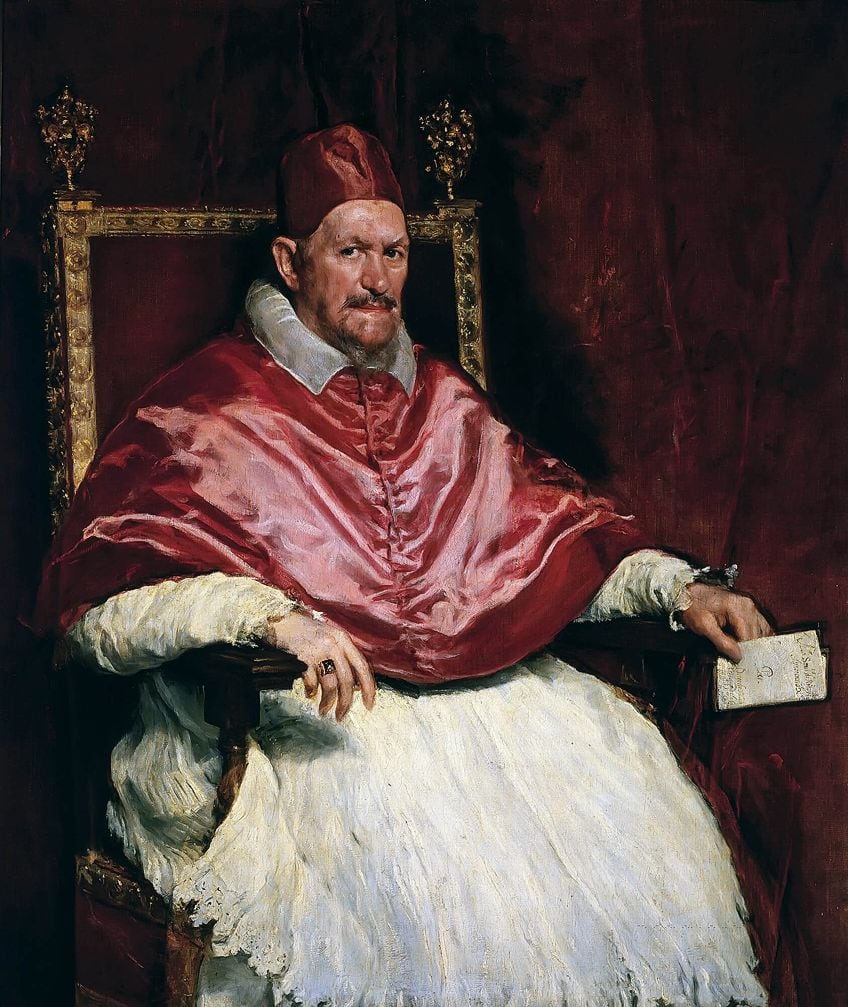
In fact, when Innocent X first saw the portrait, he complained that it was “too realistic”. The Pope, however, was not offended by Velázquez’s unflattering painting and went on to become one of his most enthusiastic admirers. Velázquez forgoes the browns and blacks of his previous works in Portrait of Pope Innocent X in favor of a red-hued palette that emphasizes the Pope’s traditional robes.
This tonal choice, however, goes beyond emphasizing the Pope’s reputation and identity and instead creates a sense of authoritative power and impending danger in the painting.
Landscape with a Calm (1651) by Nicolas Poussin
| Date of Painting’s Creation | 1651 |
| Medium of Artwork | Oil on Canvas |
| Artwork’s Dimensions | 97 cm x 132 cm |
| Place Currently Housed | J. Paul Getty Museum |
Nicolas Poussin shifted from historical narrative to landscape painting from the 1640s to the early 1650s, when he was at the peak of his maturity as an artist. Landscape with a Calm does not tell a narrative but rather creates a feeling. The serene atmosphere is aided by the well-ordered composition and warm, golden light, while vibrant, gem-like hues and fluid brushstrokes animate this scene of benevolent nature. Poussin’s drawing expeditions in the rural areas of Rome with his friend and fellow landscape painter Claude Lorrain are partly responsible for its fresh take on a cloud-strewn sky and grazing goats.
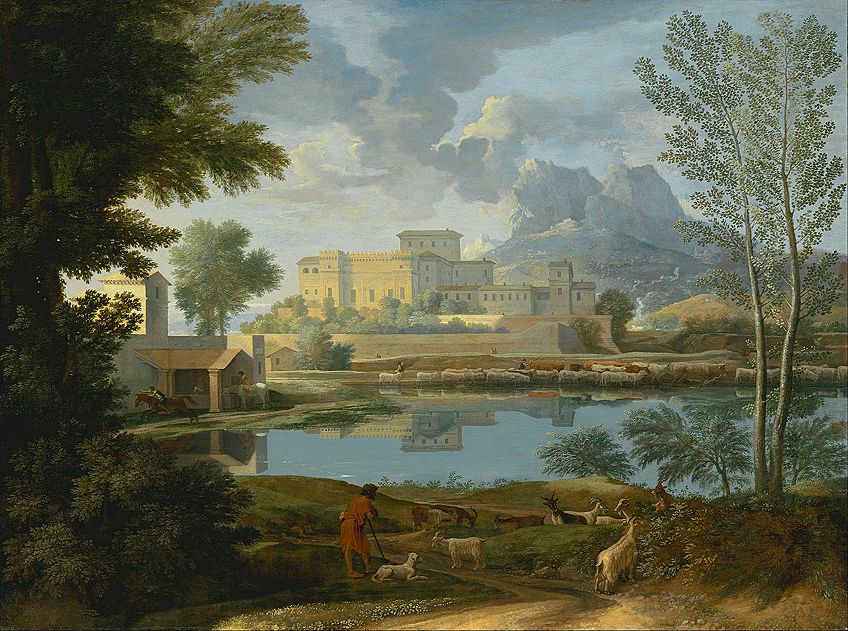
The work is lauded for Poussin’s remarkable application of the composition, which portrays numerous separate layers that appear to all pull the observer’s eye to various sections of the painting the longer one looks at the image. While the lakeside scene in the foreground is serene, the audience will make note of the formation of stormy clouds near the mountain’s summit in the distance. Landscape with a Storm, Poussin’s companion piece, is on display in the Musée de Rouen. Together, their opposing weather impacts represent the ever-changing and unpredictable nature of man’s interaction with nature.
Poussin created these pieces for his friend and longtime patron, Parisian businessman Jean Pointel.
Las Meninas (1656) by Diego Velázquez
| Date of Painting’s Creation | 1656 |
| Medium of Artwork | Oil on Canvas |
| Artwork’s Dimensions | 3,18 m x 2,76 m |
| Place Currently Housed | Museo del Prado, Madrid |
Diego Velázquez’s famous painting Las Meninas (“The Maids of Honor”), from the Spanish Golden Age, is a cultural touchstone. In the year 1656, this famous oil painting on canvas was created and is admired by academics for the unusual complexity it offers to the audience, asking issues regarding illusion vs reality and the interaction between the figures in the painting and the individual watching it. Unlike other works of art at the period, this one has sparked greater discussion because of its philosophical depth.

While the finer points of the paintings are still up for debate, historians largely agree that the room resembles the Royal Alcazar of Madrid’s principal chamber. In this painting, all the persons shown are members of the Spanish nobility, including Infanta Margaret Theresa and her courtiers. As well as them, there is a guard and two dwarf attendants, as well as a big dog. There is a portrait of the artist in the middle of the painting, staring directly into the eyes of the viewer.
According to legend, the figures in the backdrop are those of a monarch and a queen. It is because of these and many more aspects of the picture that it has become one of the most renowned Baroque paintings ever created.
The Milkmaid (1658) by Johannes Vermeer
| Date of Painting’s Creation | 1658 |
| Medium of Artwork | Oil on Canvas |
| Artwork’s Dimensions | 45 cm x 41 cm |
| Place Currently Housed | Rijksmuseum |
This relatively small painting may be considered one of the final works of the Delft painter’s developmental years, during which he borrowed diverse topics and styles from other painters while also introducing effects based on direct observation and an unusually developed aesthetic sensibility. The painting’s realism may appear photographic to modern eyes because of how accurate it appears to be. The composition, on the other hand, was meticulously planned.
This may be seen in the several modifications made throughout the process, as well as the completed work’s delicate interactions of shading and lighting, color, curves, and forms.

The lady in the artwork was most likely referred to as a “kitchen maid” rather than a “milkmaid” when it was painted. Vermeer portrays the woman as a sturdy young woman. There are stunning details, but there is also a feeling of the woman’s and the table’s weight to it. A Delft tile to the right of the foot warmer depicts a wandering person with a walking staff and a bag. This might imply that the woman is lamenting over a lost love. Milkmaid is not just one of Vermeer’s most renowned paintings, but also one of the most well-known Baroque artworks.
Portia Wounding Her Thigh (1664) by Elisabetta Sirani
| Date of Painting’s Creation | 1664 |
| Medium of Artwork | Oil on Canvas |
| Artwork’s Dimensions | 101 cm by 138 cm |
| Place Currently Housed | Rijksmuseum, Amsterdam |
Portia Wounding Her Thigh by Elisabetta Sirani depicts a historical event from Roman times. According to some historians, Brutus’ wife Portia Catonis was either directly engaged in the Julius Caesar assassination conspiracy or was the only other woman who knew about it first. According to Plutarch’s account, she found her husband contemplating the execution but refused to tell him about it for fear that he would expose the plot if she was put to death. Portia sliced her leg to prove she could endure physical discomfort for a day (despite running a high fever).

She then went back to her spouse with proof that she was able to preserve her secrets. There are bold brushstrokes but rather vibrant colors in this painting, making it a striking piece of art. A powerful Portia is depicted; her posture communicates her willpower and determination. Her pale complexion and bloody thigh contrast her crimson dress. To enter the world of men, Portia drew blood from her veins, which set her apart from other women. The painting tells us a lot about Portia and Sirani’s personalities, such as their will to succeed and intelligence.
Sirani intended this painting to make a political statement about the extent to which women would go to be taken seriously.
The Return of the Prodigal Son (1669) by Rembrandt van Rijn
| Date of Painting’s Creation | 1669 |
| Medium of Artwork | Oil on Canvas |
| Artwork’s Dimensions | 262 cm x 205 cm |
| Place Currently Housed | Hermitage Museum Saint Petersburg |
In the parable of the prodigal son, a dad has two children, one of whom asks for his birthright, spends his money, and comes home upon becoming impoverished. He’s trying to convince his dad to make him one of his workers, but instead, he’s greeted with a party in honor of his triumphant homecoming. The father explains to his eldest son that they are rejoicing because their long-lost sibling has now returned to reality. In Rembrandt’s picture, the son has just returned home, and he is in a very bad state.
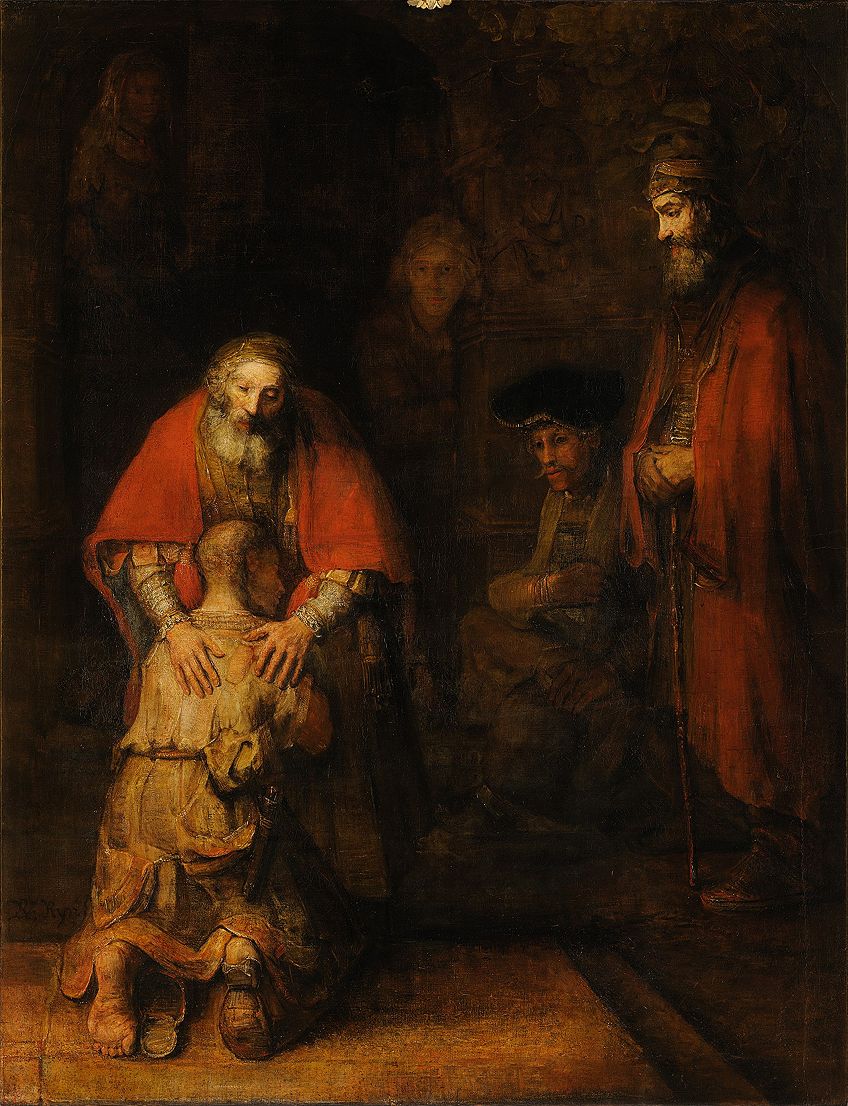
One can see the dad making a loving gesture to receive his offspring, while the other sibling has his hands crossed in judgment. With his signature light and shadow techniques, Rembrandt is known for his paintings’ extraordinary realism. The artwork, painted towards the conclusion of his career, shows his expertise as he combines emotive lighting and color to wonderfully communicate the parable’s message of forgiveness to the audience.
Many art experts consider this painting to be Rembrandt’s finest work, and it is a towering achievement in Baroque period artwork.
The Love Letter (c. 1669) by Johannes Vermeer
| Date of Painting’s Creation | c. 1669 |
| Medium of Artwork | Oil on Canvas |
| Artwork’s Dimensions | 44 cm x 38 cm |
| Place Currently Housed | Rijksmuseum, Amsterdam |
The love letter’s content, the view into neighboring rooms, and the inclusion of items like the lute, brush, and shoes, as well as the atlas on the doorway, can all be found in other paintings of interiors by Vermeer and show the artist’s connections to his contemporaries. Vermeer’s paintings throughout the latter part of his career, from approximately 1669 until he passed away in 1675, show a stronger inclination towards abstraction of shapes and not as much focus on detail as in his works created earlier, as seen here.
This painting’s topic is love, which is demonstrated by the existence of musical allusions. The young woman is holding a letter, most likely from a loved one, about whom she chats with the servant.
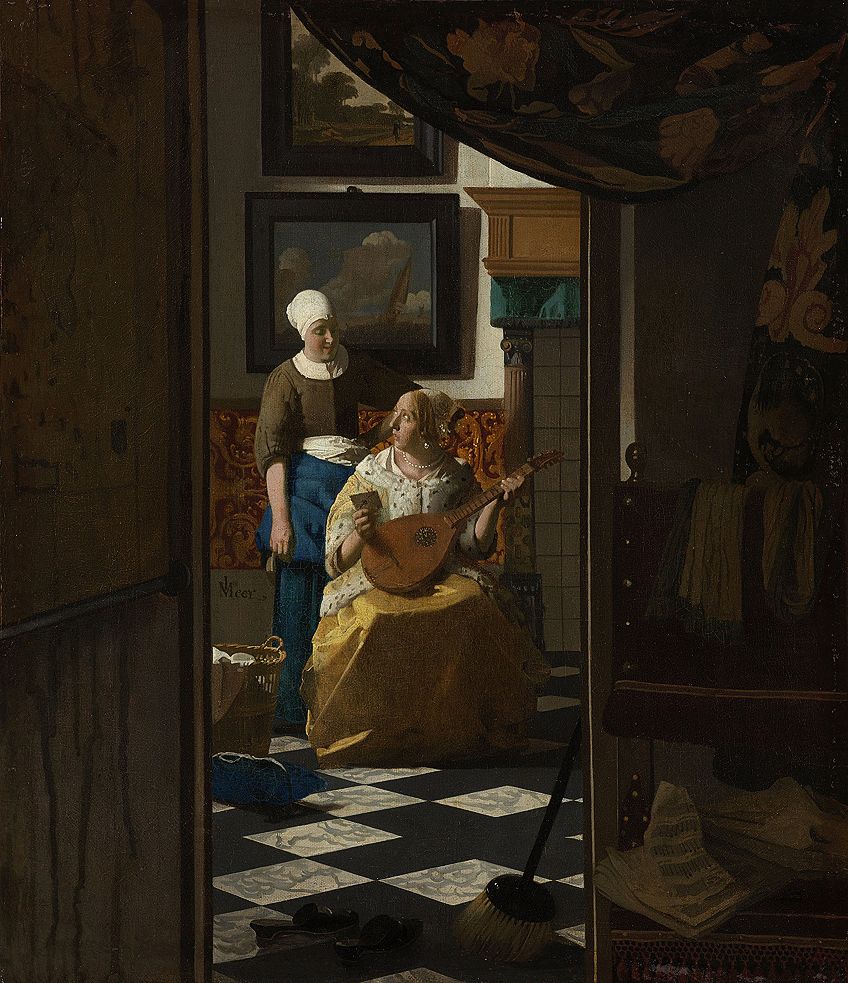
One element that has stayed consistent is Vermeer’s ability to manage the spectator’s interaction with the painting through the building of space. Interior scene artists frequently incorporated paintings within paintings to clarify the meaning of the composition. The fact that our sight cannot penetrate the characters in the back makes us feel like invaders in an intimate space to which we have not been welcomed. In this way, this picture encapsulates a crucial feature of every interior painting: the pleasure derived from being able to peer into the private lives of others.
That brings to a close our look at the most famous Baroque Paintings. Baroque painting’s breathtaking realism and the dynamic subject matter set it apart from earlier periods. During the Baroque period, artists tried to capture the visual drama and movement of their day by emphasizing spiritual and theological subjects. Baroque art has long been linked with the Catholic Church, and its supporters believed it was meant to inspire both devotion and awe. The decorative arts are extravagant and extensive in this design’s ornamentation. Each country’s departure from Renaissance classicism takes on a different appearance.
Take a look at our Baroque paintings webstory here!
Frequently Asked Questions
What Is Baroque Painting?
Italian Baroque painting as well as other Baroque artworks initially started to arise in Europe between the early 17th century and the mid-18th century. Artists of the era created magnificent Baroque artworks that may be identified by their use of rich colors, thrilling details, contrast, and a feeling of grandeur.
What Are the Characteristics of Famous Baroque Paintings?
17th-century art and specifically Baroque art can be recognized by a few key characteristics. One of them is the sense of awe-inspiring grandeur, while the other is the use of lighting and shadows to create an effect of drama. The artists also blurred the divisions between the styles of the time. The colors used in the compositions were rich, and a feeling of exuberance and dynamism are also apparent in artworks from this era.
Isabella studied at the University of Cape Town in South Africa and graduated with a Bachelor of Arts majoring in English Literature & Language and Psychology. Throughout her undergraduate years, she took Art History as an additional subject and absolutely loved it. Building on from her art history knowledge that began in high school, art has always been a particular area of fascination for her. From learning about artworks previously unknown to her, or sharpening her existing understanding of specific works, the ability to continue learning within this interesting sphere excites her greatly.
Her focal points of interest in art history encompass profiling specific artists and art movements, as it is these areas where she is able to really dig deep into the rich narrative of the art world. Additionally, she particularly enjoys exploring the different artistic styles of the 20th century, as well as the important impact that female artists have had on the development of art history.
Learn more about Isabella Meyer and the Art in Context Team.
Cite this Article
Isabella, Meyer, “Famous Baroque Paintings – Exploring the Best Baroque Period Artworks.” Art in Context. September 26, 2021. URL: https://artincontext.org/famous-baroque-paintings/
Meyer, I. (2021, 26 September). Famous Baroque Paintings – Exploring the Best Baroque Period Artworks. Art in Context. https://artincontext.org/famous-baroque-paintings/
Meyer, Isabella. “Famous Baroque Paintings – Exploring the Best Baroque Period Artworks.” Art in Context, September 26, 2021. https://artincontext.org/famous-baroque-paintings/.




